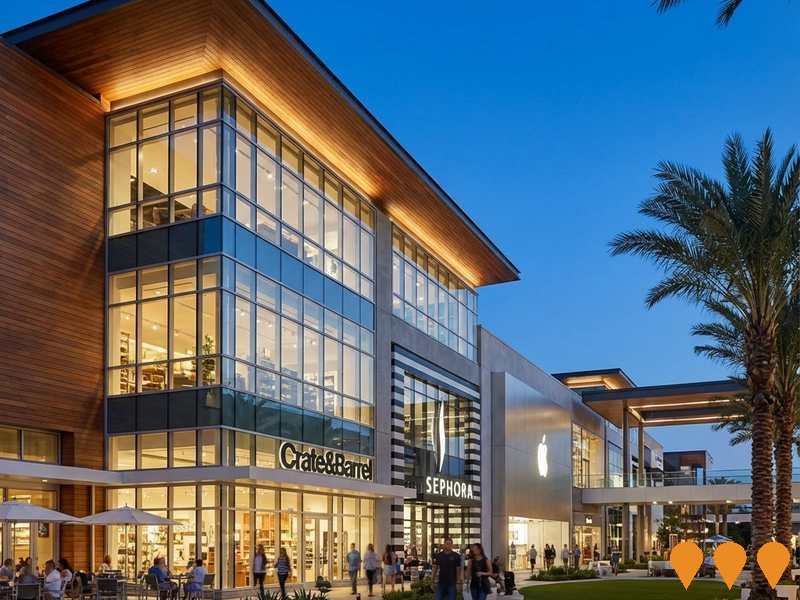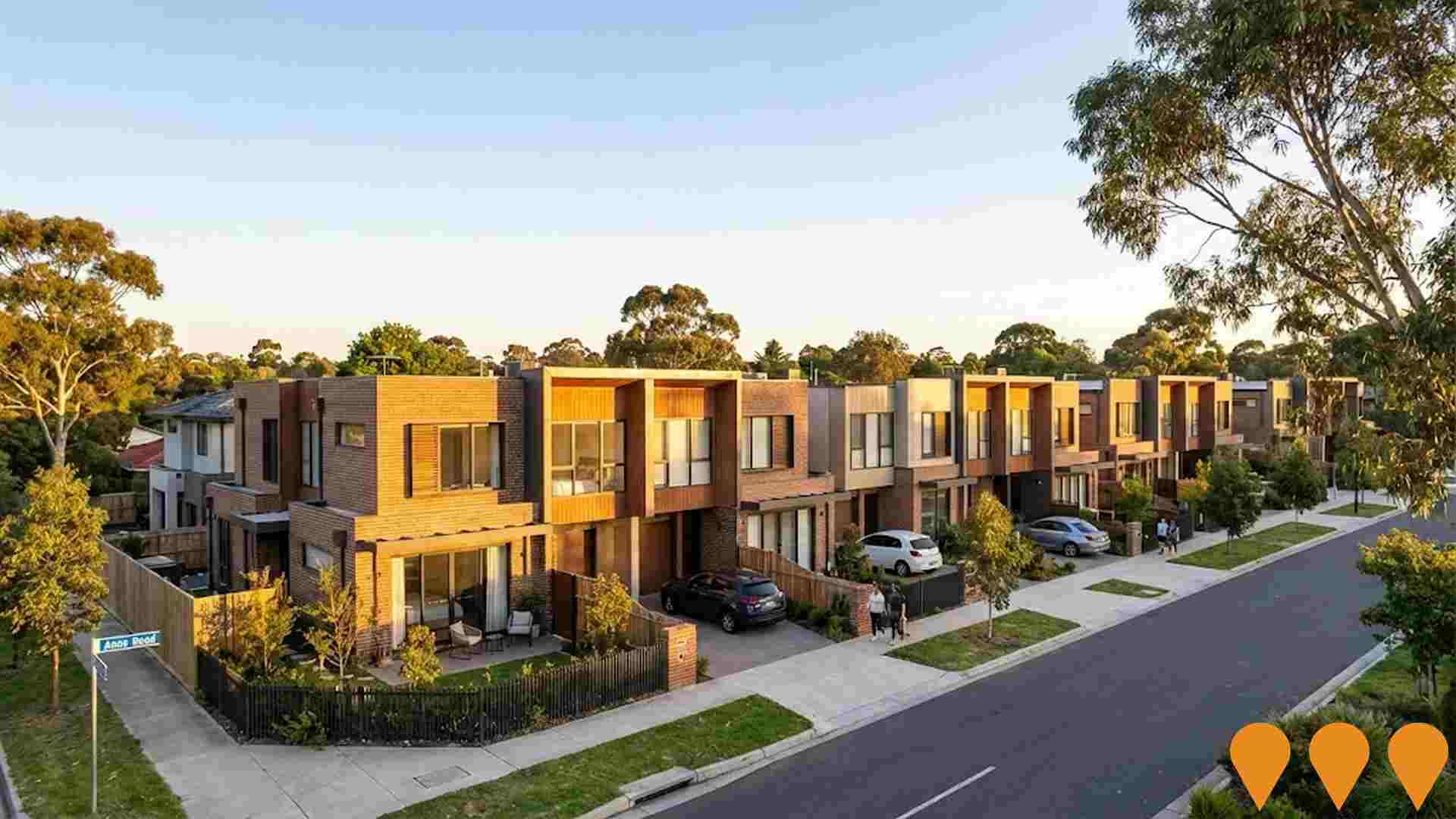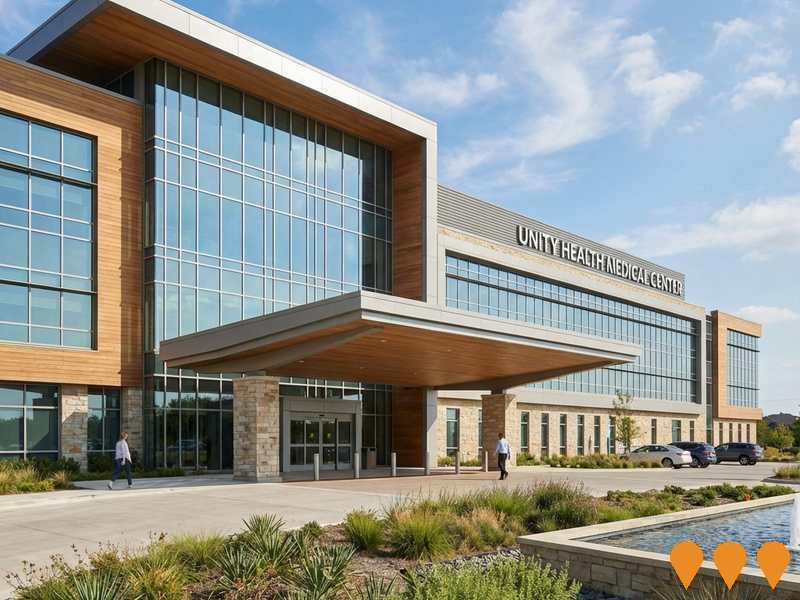Chart Color Schemes
est. as @ -- *
ABS ERP | -- people | --
2021 Census | -- people
Sales Activity
Curious about local property values? Filter the chart to assess the volume and appreciation (including resales) trends and regional comparisons, or scroll to the map below view this information at an individual property level.
Find a Recent Sale
Sales Detail
Population
An assessment of population growth drivers in Ferntree Gully (South) - Upper Ferntree Gully reveals an overall ranking slightly below national averages considering recent, and medium term trends
Ferntree Gully (South) - Upper Ferntree Gully's population is around 15,830 as of Aug 2025. This reflects an increase of 496 people since the 2021 Census, which reported a population of 15,334 people. The change is inferred from the estimated resident population of 15,690 from the ABS as of June 2024 and an additional 96 validated new addresses since the Census date. This level of population equates to a density ratio of 1,730 persons per square kilometer. Ferntree Gully (South) - Upper Ferntree Gully's growth rate of 3.2% since census positions it within 0.7 percentage points of the SA3 area's growth rate of 3.9%. Population growth for the area was primarily driven by overseas migration, contributing approximately 54.2% of overall population gains during recent periods.
AreaSearch is adopting ABS/Geoscience Australia projections for each SA2 area, as released in 2024 with a base year of 2022. For areas not covered by this data, AreaSearch utilises the VIC State Government's Regional/LGA projections released in 2023, adjusted employing a method of weighted aggregation of population growth from LGA to SA2 levels. Growth rates by age group are applied across all areas for years 2032 to 2041. Based on demographic trends and latest population numbers, the area is expected to grow by 510 persons to 2041, recording a gain of 1.8% in total over the 17 years.
Frequently Asked Questions - Population
Development
Residential development activity is lower than average in Ferntree Gully (South) - Upper Ferntree Gully according to AreaSearch's national comparison of local real estate markets
Ferntree Gully (South) - Upper Ferntree Gully has seen approximately 41 new homes approved annually. Over the past five financial years, from FY21 to FY25, around 207 homes were approved, with an additional 21 approved in FY26 so far. On average, about 0.3 people moved to the area per dwelling built over these years.
This suggests that new supply is meeting or exceeding demand, providing ample buyer choice and capacity for population growth beyond current forecasts. New properties are constructed at an average cost of $550,000. In FY26, commercial development approvals totalled $45.3 million, indicating high local commercial activity. Comparatively, Ferntree Gully (South) - Upper Ferntree Gully has around two-thirds the rate of new dwelling approvals per person when measured against Greater Melbourne. Nationally, it ranks in the 33rd percentile of areas assessed, resulting in relatively constrained buyer choice and supporting interest in existing dwellings.
This activity is lower than the national average, reflecting market maturity and possible development constraints. New building activity shows 67% detached houses and 33% medium to high-density housing. This shift from the area's current 92% houses indicates decreasing availability of developable sites and reflects changing lifestyles and demand for more diverse, affordable housing options. With around 522 people per dwelling approval, Ferntree Gully (South) - Upper Ferntree Gully shows a developed market. Population forecasts indicate it will gain approximately 280 residents by 2041. Based on current development patterns, new housing supply should readily meet demand, offering good conditions for buyers and potentially facilitating population growth beyond current projections.
Frequently Asked Questions - Development
Infrastructure
Ferntree Gully (South) - Upper Ferntree Gully has strong levels of nearby infrastructure activity, ranking in the top 40% nationally
Changes to local infrastructure significantly influence an area's performance. AreaSearch has identified 16 projects likely impacting the region. Notable initiatives include Kings Park Masterplan, Angliss Hospital Expansion, 13 Mountain Gate Drive Townhouses, and Knoxfield Development Victoria Project. The following list details those projects deemed most relevant.
Professional plan users can use the search below to filter and access additional projects.
INFRASTRUCTURE SEARCH
 Denotes AI-based impression for illustrative purposes only, not to be taken as definitive under any circumstances. Please follow links and conduct other investigations from the project's source for actual imagery. Developers and project owners wishing us to use original imagery please Contact Us and we will do so.
Denotes AI-based impression for illustrative purposes only, not to be taken as definitive under any circumstances. Please follow links and conduct other investigations from the project's source for actual imagery. Developers and project owners wishing us to use original imagery please Contact Us and we will do so.
Frequently Asked Questions - Infrastructure
Angliss Hospital Expansion
Major redevelopment of Angliss Hospital including a new four-storey tower with a 32-bed inpatient unit, four new operating theatres, a new central sterile supply department, expanded outpatient services and a new main entrance. The all-electric expansion will increase surgical capacity and support growing healthcare demand in Melbourne's outer east.
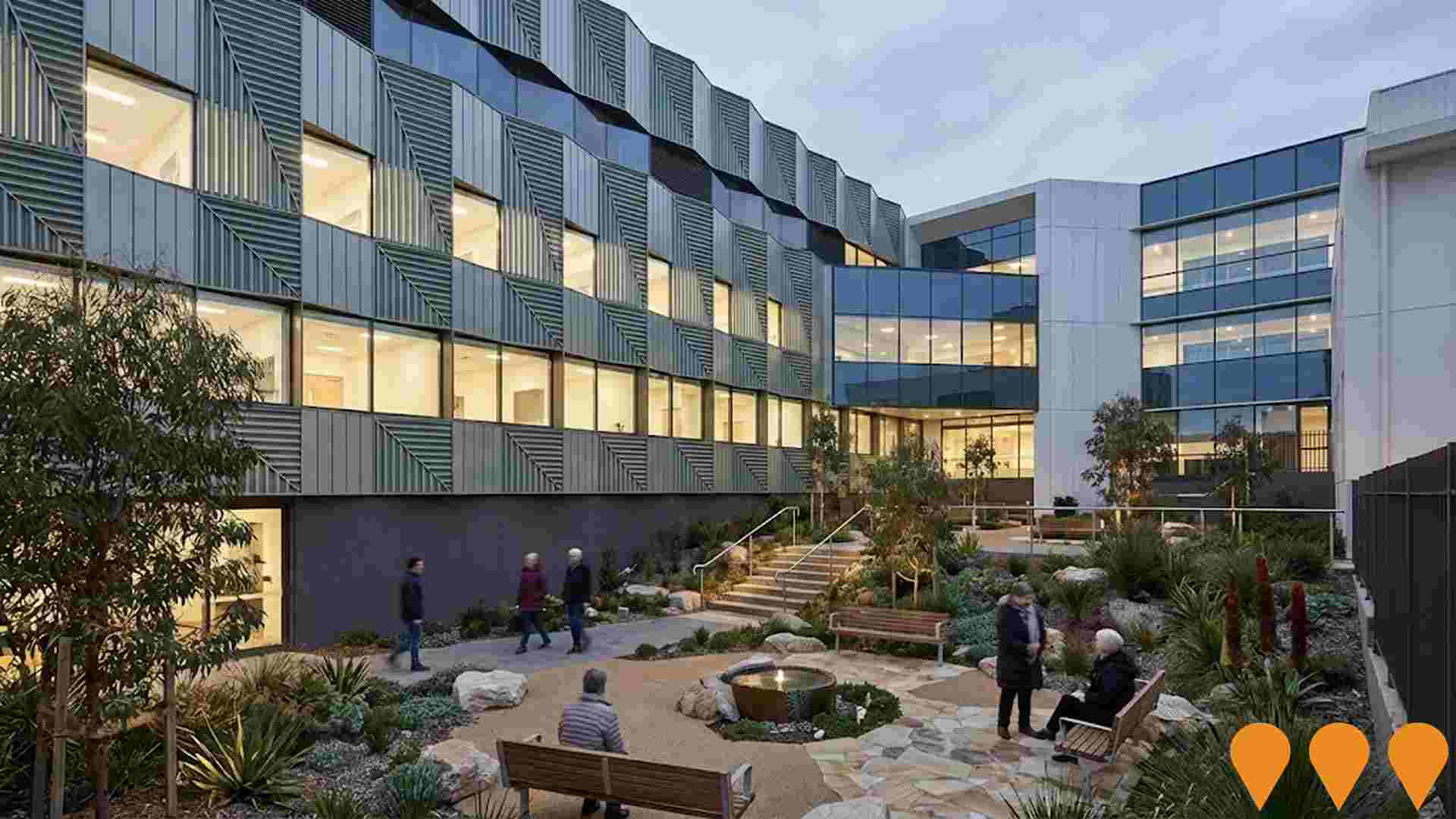
Knoxfield Industrial Estate Redevelopment
Strategic long term plan to reposition the existing Knoxfield Industrial Estate at 20 Henderson Road into a higher amenity industrial and logistics precinct, with upgraded road access, internal circulation and infrastructure. The estate currently operates as a large distribution focused industrial park while Knox City Council and private sector partners progress planning and staging options for future redevelopment.
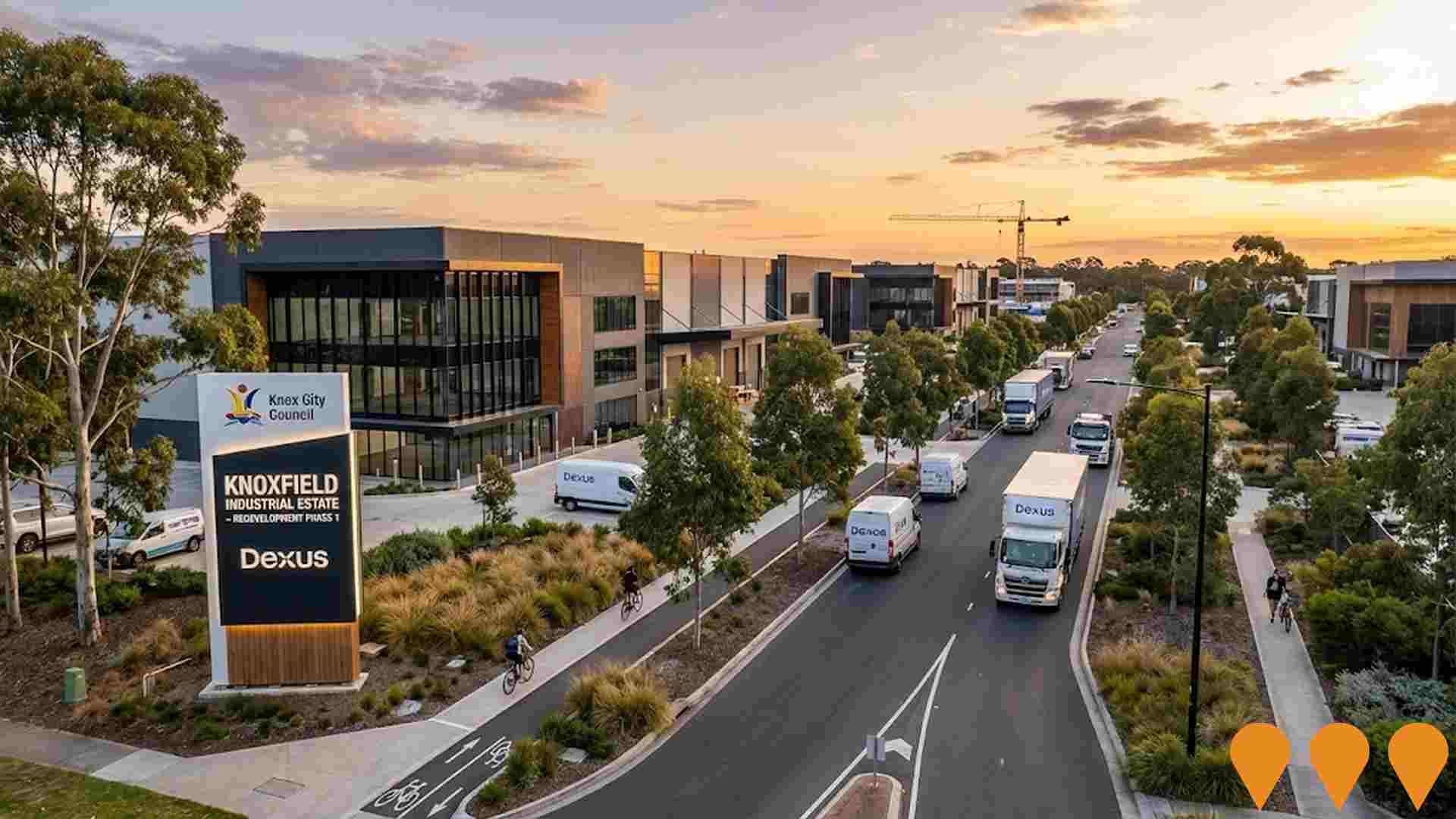
Ferntree Gully Village Creative Placemaking Plan
Community-driven arts and cultural development project transforming public spaces in Ferntree Gully Village through murals, sculptures, lightbox galleries, and parklet upgrades to enhance safety, community connection, and local pride.
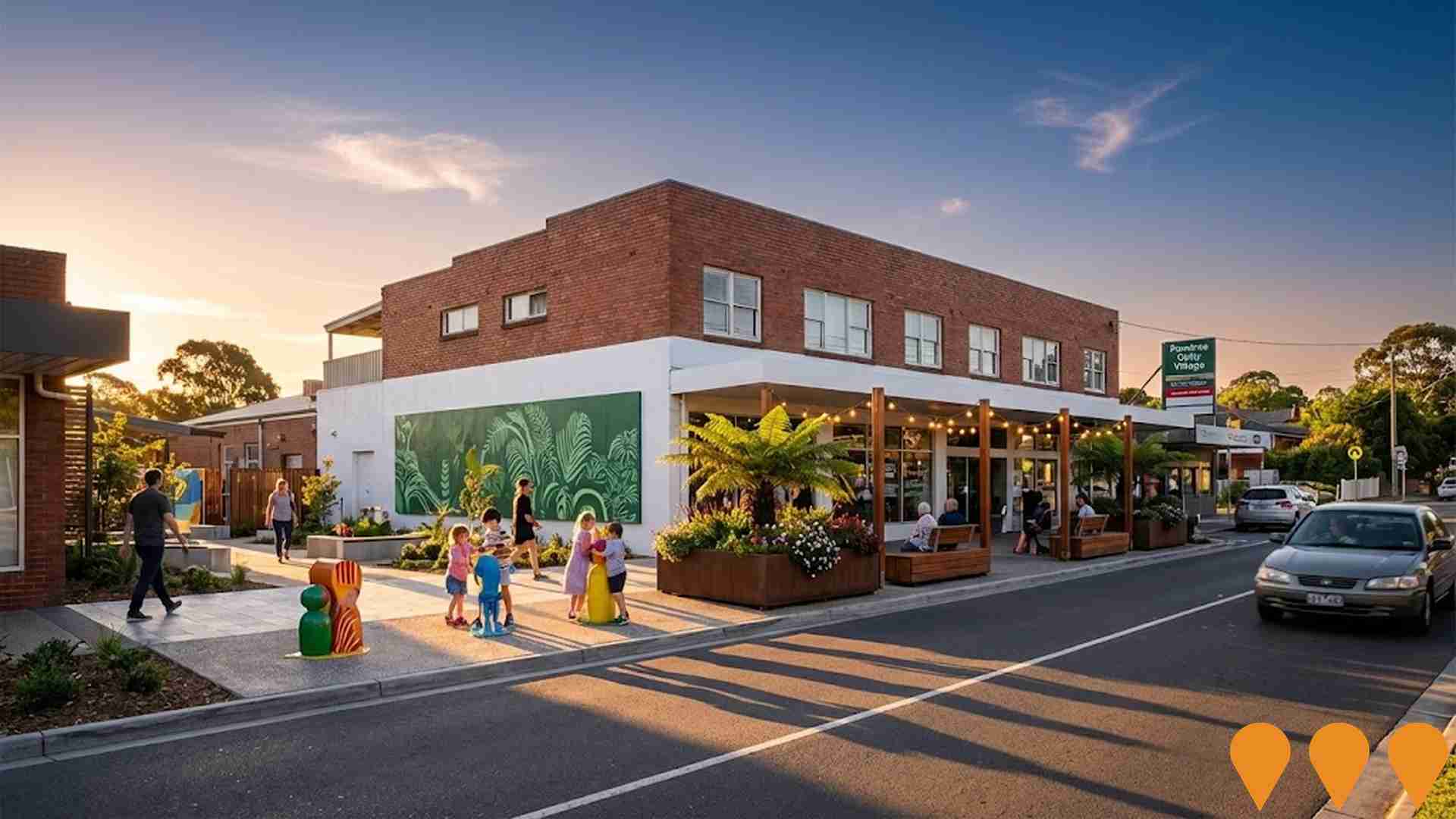
Scoresby Village Residential Estate
Large master planned residential community in Scoresby delivering more than 450 new dwellings in a mix of townhouses and apartments, with internal streets, pocket parks and integrated community open space directly adjoining the Knoxfield activity area and Scoresby Village shopping precinct.
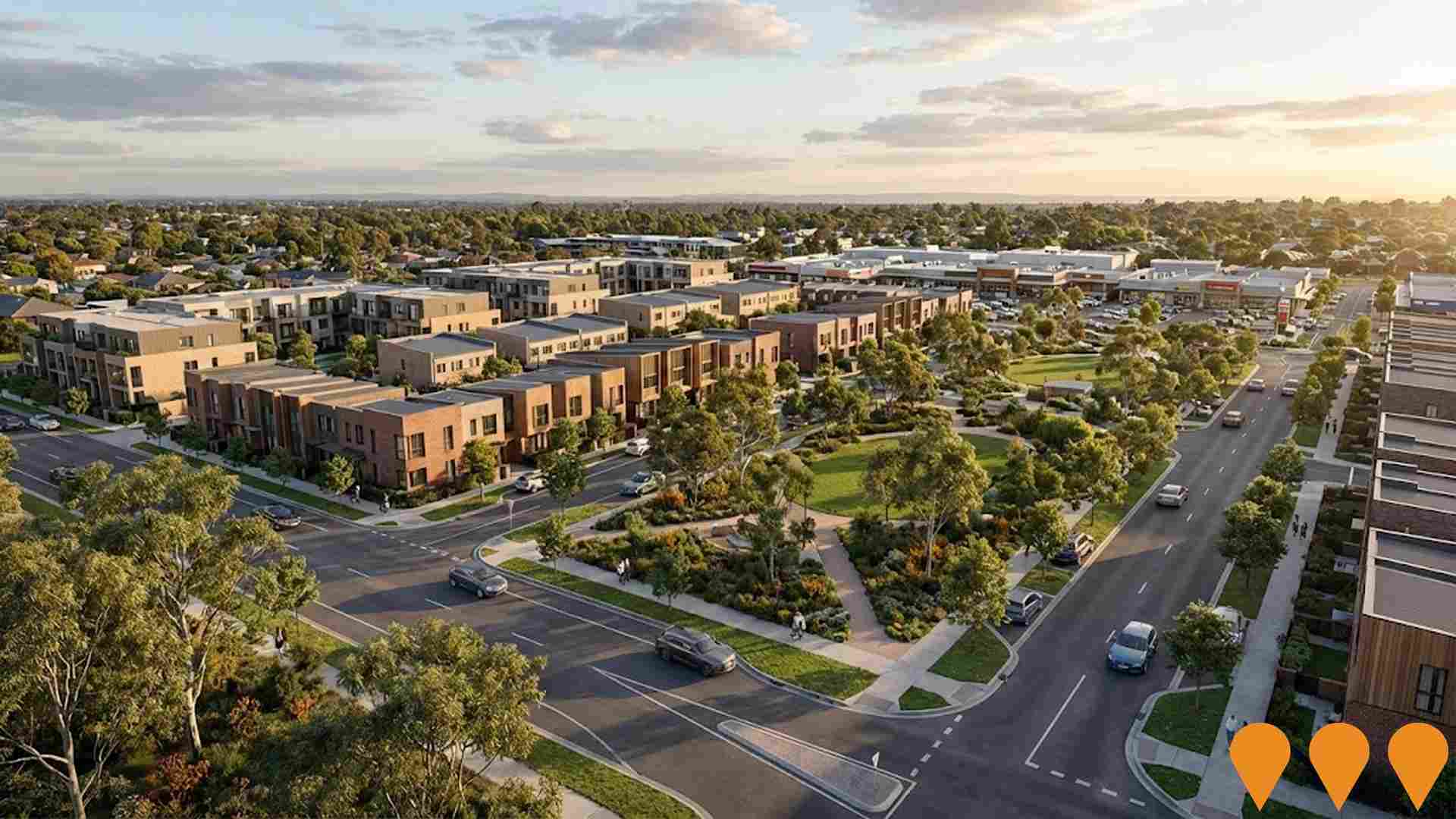
Ferntree Gully Community Housing
A 79-unit medium density development consisting of 41 one-bedroom units, 38 two-bedroom units, and 6 three-bedroom units, located on the site of the old Ferntree Gully Primary School. Part of the Nation Building and Economic Stimulus Project, jointly funded by Federal and State Governments. Residents are involved in a community vegetable garden and linked with local community activities through partnerships with Mountain District Learning Centre.

Knoxfield Development Victoria Project
Development Victoria project delivering approximately 400 homes across 2-4 bedroom dwellings in Knoxfield on former DELWP horticultural research facility site. Features vibrant new neighbourhood with diverse housing, enhanced wetland area replacing structurally unsound existing dam, public open spaces, recreational facilities and mixed-use precinct. Up to 10% affordable housing commitment. Targets Green Star Communities rating with world-class sustainability practices. Construction commenced mid-2025 with housing sales beginning late 2025, signalized intersection at Scoresby Road planned.

Burwood Highway-McMahons Road Intersection Upgrade
Upgraded intersection at Burwood Highway, McMahons Road and Clyde Street in Ferntree Gully completed in 2024. Includes extra lanes in each direction on Burwood Highway, new traffic lights with dedicated pedestrian crossings, more street lights, dedicated right turn lanes, shared left turn and through lanes, and a dedicated left turn lane into Clyde Street with improved business access. Improves safety, reduces crashes, and enhances traffic flow.

Kings Park Masterplan
Knox City Councils long term plan to guide upgrades at Kings Park, a major local sports and recreation hub. Stage 1 is a new fenced dog park with two separate off leash areas, path circuits, seating, picnic facilities, drinking fountain and improved drainage. Council indicates construction commenced May 2025 with completion anticipated October 2025. Future projects in the masterplan remain subject to feasibility, community engagement and annual budget processes.
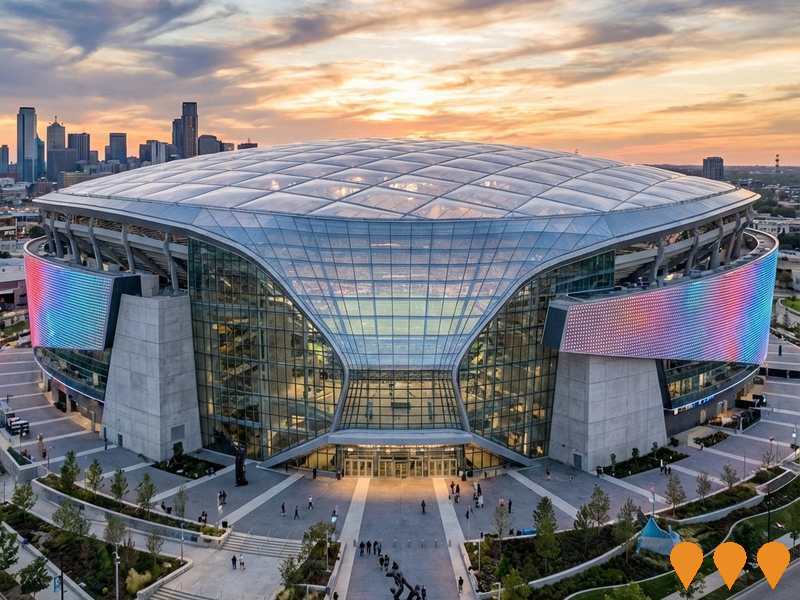
Employment
AreaSearch analysis indicates Ferntree Gully (South) - Upper Ferntree Gully maintains employment conditions that align with national benchmarks
Ferntree Gully (South) - Upper Ferntree Gully has a skilled workforce with the construction sector being prominently represented. Its unemployment rate was 3.9% as of June 2021 and it experienced an estimated employment growth of 0.8% over the past year.
As of June 2025, 8702 residents were employed, with an unemployment rate of 3.9%, which is 0.7% lower than Greater Melbourne's rate of 4.6%. Workforce participation was at 66.9%, slightly higher than Greater Melbourne's 64.1%. The leading employment industries among residents were health care & social assistance, construction, and retail trade. Construction showed particularly strong specialization with an employment share of 1.3 times the regional level.
Conversely, professional & technical services had lower representation at 7.6% compared to the regional average of 10.1%. Over the year to June 2025, employment increased by 0.8%, while labour force increased by 0.7%, leading to a decrease in unemployment by 0.1 percentage points. In comparison, Greater Melbourne recorded employment growth of 3.5% and unemployment rose by 0.5 percentage points during the same period. Jobs and Skills Australia's national employment forecasts from May 2025 project national employment growth of 6.6% over five years and 13.7% over ten years, with varying rates across industry sectors. Applying these projections to Ferntree Gully (South) - Upper Ferntree Gully's employment mix suggests local growth of approximately 6.4% over five years and 13.3% over ten years.
Frequently Asked Questions - Employment
Income
Income analysis reveals strong economic positioning, with the area outperforming 60% of locations assessed nationally by AreaSearch
AreaSearch's latest postcode level ATO data for financial year 2022 shows that median income in Ferntree Gully (South) - Upper Ferntree Gully is $53,525 and average income stands at $66,129. This contrasts with Greater Melbourne's figures of a median income of $54,892 and an average income of $73,761. Based on Wage Price Index growth of 12.16% since financial year 2022, current estimates would be approximately $60,034 (median) and $74,170 (average) as of September 2025. Census 2021 income data indicates that household, family and personal incomes in Ferntree Gully (South) - Upper Ferntree Gully cluster around the 57th percentile nationally. Income brackets show that the $1,500 - 2,999 earnings band captures 36.1% of the community (5,714 individuals), aligning with the metropolitan region where this cohort likewise represents 32.8%. After housing, 85.6% of income remains for other expenses and the area's SEIFA income ranking places it in the 6th decile.
Frequently Asked Questions - Income
Housing
Ferntree Gully (South) - Upper Ferntree Gully is characterized by a predominantly suburban housing profile, with ownership patterns similar to the broader region
Ferntree Gully (South) - Upper Ferntree Gully had 92.4% houses and 7.7% other dwellings at the latest Census, compared to Melbourne metro's 83.4% houses and 16.7% other dwellings. Home ownership in Ferntree Gully (South) - Upper Ferntree Gully was 35.3%, with mortgaged dwellings at 46.6% and rented dwellings at 18.1%. The median monthly mortgage repayment was $1,950, below Melbourne metro's average of $2,000. Median weekly rent in the area was $405, compared to Melbourne metro's $400. Nationally, Ferntree Gully (South) - Upper Ferntree Gully's mortgage repayments were higher at $1,950 than the Australian average of $1,863, while rents exceeded the national figure of $375.
Frequently Asked Questions - Housing
Household Composition
Ferntree Gully (South) - Upper Ferntree Gully features high concentrations of family households, with a fairly typical median household size
Family households constitute 77.8% of all households, consisting of 38.6% couples with children, 25.6% couples without children, and 12.5% single parent families. Non-family households comprise the remaining 22.2%, with lone person households at 19.6% and group households making up 2.5% of the total. The median household size is 2.7 people, which aligns with the Greater Melbourne average.
Frequently Asked Questions - Households
Local Schools & Education
The educational profile of Ferntree Gully (South) - Upper Ferntree Gully exceeds national averages, with above-average qualification levels and academic performance metrics
The area's university qualification rate of 26.1% falls significantly below Greater Melbourne's average of 37.0%. Bachelor degrees are the most prevalent at 17.5%, followed by postgraduate qualifications (5.7%) and graduate diplomas (2.9%). Vocational credentials are common, with 36.1% of residents aged 15+ holding them, including advanced diplomas (12.4%) and certificates (23.7%). Educational participation is high at 27.3%, comprising primary education (8.7%), secondary education (7.6%), and tertiary education (4.8%).
Ferntree Gully (South) - Upper Ferntree Gully's four schools have a combined enrollment of 1,684 students, with typical Australian school conditions (ICSEA: 1042) offering balanced educational opportunities. The area has three primary and one secondary school serving distinct age groups.
Frequently Asked Questions - Education
Schools Detail
Nearby Services & Amenities
Transport
Transport servicing is good compared to other areas nationally based on assessment of service frequency, route connectivity and accessibility
Ferntree Gully (South) - Upper Ferntree Gully has 81 active public transport stops. These are served by a mix of trains and buses, with 21 individual routes operating in total. Together, these routes facilitate 4707 weekly passenger trips.
The area's transport accessibility is rated as good, with residents typically located 277 meters from the nearest stop. On average, services run 672 trips per day across all routes, equating to approximately 58 weekly trips per individual stop.
Frequently Asked Questions - Transport
Transport Stops Detail
Health
Ferntree Gully (South) - Upper Ferntree Gully's residents are relatively healthy in comparison to broader Australia with common health conditions slightly more prevalent than average across both younger and older age cohorts
Ferntree Gully South's health metrics are close to national benchmarks.
Common health conditions are slightly more prevalent than average across both younger and older age cohorts, with mental health issues impacting 8.8% of residents and asthma affecting 8.2%. Private health cover is held by approximately 52% of the total population (~8,294 people), leading the average SA2 area rate. About 68.5% of residents declare themselves completely clear of medical ailments, compared to 69.4% across Greater Melbourne. The area has 18.1% of residents aged 65 and over (2,865 people), which is lower than the 19.5% in Greater Melbourne. This aligns broadly with the general population's health profile.
Frequently Asked Questions - Health
Cultural Diversity
Ferntree Gully (South) - Upper Ferntree Gully was found to be more culturally diverse than the vast majority of local markets in Australia, upon assessment of a range of language and cultural background related metrics
Ferntree Gully (South) - Upper Ferntree Gully had a higher cultural diversity compared to most local markets, with 26.1% of its population born overseas and 19.1% speaking a language other than English at home. Christianity was the dominant religion in Ferntree Gully (South) - Upper Ferntree Gully, comprising 43.4% of the population. However, Buddhism had a higher representation in Ferntree Gully (South) - Upper Ferntree Gully with 3.1%, compared to 4.6% across Greater Melbourne.
The top three ancestry groups were English at 26.2%, Australian at 24.7%, and Other at 7.9%. Notable differences included Dutch, overrepresented at 2.2% compared to the regional average of 1.8%, Sri Lankan at 1.1% (vs 1.4%), and Hungarian at 0.4% (vs 0.4%).
Frequently Asked Questions - Diversity
Age
Ferntree Gully (South) - Upper Ferntree Gully's population is slightly older than the national pattern
The median age in Ferntree Gully (South) - Upper Ferntree Gully is 39 years, higher than Greater Melbourne's average of 37 years, which is close to the national average of 38 years. The 55-64 age group is over-represented at 12.9%, while the 25-34 age group is under-represented at 11.0%. Post-2021 Census data shows the 75 to 84 age group grew from 4.8% to 6.0% of the population, and the 25 to 34 cohort declined from 13.0% to 11.0%. Population forecasts for 2041 indicate significant demographic changes. The 75 to 84 age group is expected to grow by 46%, reaching 1,397 people from 956. Residents aged 65 and older are anticipated to represent 80% of the population growth. Conversely, the 25 to 34 and 15 to 24 age groups are projected to experience population declines.
